2022 TMR Alumni Reunion
2022 TMR Alumni Reunion
With 2023 Updates
 |
 |
 |
 |
| Wildcat Trail | Camp Kunatah | TMR Museum | Camp Aquehonga |
Scout camps have been in the news a lot lately. With the BSA bankruptcy and abuse settlement requiring contributions from all councils, countless Scout camp properties have been put up for sale. To make their contribution, the Greater New York Councils agreed to part with the bulk of the Ten Mile River Scout Camps property in a deal that would preserve the land and the Scouts’ access to it while opening up areas outside the active camp properties to the public. It was perhaps the least worst outcome, but it’s hard to see it as anything but a loss.
TMR was very familiar to me in my childhood. Between summer camp at Camp Aquehonga and Junior Leader Training, OA ordeal weekends, and the occasional camporee at Camp Ranachqua, I spent the equivalent of more than two months there between 1989 and 1994. That might not sound like much to anyone who was on camp staff, but taking that many trips down the camp roads leaves an impression on you. Especially when those roads hadn’t been recently repaired.

I didn’t know it at the time, but this photo of the new Camp Ranachqua trading post porch after the June ordeal weekend in 1994 would be my final view of TMR as a Scout. Life got in the way after that, as it does for almost everyone at some point.
What followed at TMR was the continuation of the cycle of change. Skanondo Lodge hosted a final conclave in 1995 before merging the following March into Nacha Nimat. The Hudson-Delaware Council, which had been leasing Camp Ranachqua, gave way to the Hudson Valley Council. The TMR museum opened its doors, figuratively and later literally, to tell the story of TMR and what came before its creation in 1927. And the GNYC eventually resumed operation of Camp Ranachqua and opened TMR’s camps to Scouts from all councils. Another merger brought an end to a quarter of a century of the Hudson Valley Council and Nacha Nimat Lodge. And now TMR itself would be changing.
That was the situation in 2022 as I was working on uncovering the history and memorabilia of the Hudson-Delaware Council and the previous incarnations of Council 392. So I suppose it was only natural that a return to TMR would be part of the process. After all, there was nothing left to visit of the council’s previous camp except empty land. I had heard about TMR’s alumni reunions over a decade earlier and I had wanted to check out the museum for a while. Maybe the time was finally right.
Initially, it was the promise of a trade-o-ree that caught my attention – there were no such events to be held anywhere else in the now Greater Hudson Valley Council. Then the hike to Indian Cliffs and Rock Lake, parts of TMR I had never visited as a Scout, looked interesting. Finally, lunch at Camp Aquehonga would be a great opportunity to see the many improvements that had been made in recent years. It just made too much sense, I couldn’t pass this up.
Part One: Wildcat Trail
I set out on Friday morning to make my first trip to TMR in 28 years. And it would be my first time driving there. On top of that, I would be approaching from the south via Port Jervis for the first time rather than from the north via Monticello – with the meeting location set as the Tusten Stone Arch Bridge, that just made the most sense. It was going to be a day of firsts.
The road from Port Jervis offers scenic views of the Delaware River, which was the lowest I’d ever seen it – and I’ve been on it in years when you would have to get out of your canoe and walk in some sections. Still, people were out fishing or kayaking in what was left of the river. After a relaxing drive, a few sharp turns and a very sketchy dirt road brought me to the historic bridge and the start of the day’s adventure.

Decades after I first set foot on TMR, this was my first time seeing the river it was named after. The Tenmile River flows into the Delaware River a short distance past the bridge.

The area has a history that predates TMR by more than half a century. The abundance of natural resources and proximity to transportation on the Delaware River (and later the railroad) made it ideal for sourcing stone and lumber. These same qualities would play a part in its selection as the site for New York City’s new Scout camps, designed to last for a century or more.
At the bridge, I met up with Johannes Knoops, chair of the TMR Alumni Association, and Jason Scheib, who would be leading the hike. My gear for the hike consisted of my trusty hiking staff and a small day pack with two bottles of water, a sandwich, a small first aid kit, and ten pounds of camera gear – just the basics.

Our trek began with the Wildcat Trail, part of the red dot TMR trail that follows the path Scouts would have taken from the Tusten train station to the camps at Rock Lake. It traverses what is perhaps the most rugged terrain at TMR, featuring huge rock formations carved out by glaciers and worn away by water and vegetation, culminating in the spectacular view at Indian Cliffs. We would be retracing part of the camp’s history, in more ways than we were aware at the time.
95 years earlier, on November 8, 1927, a group of 23 Scouts and three adult leaders from Sullivan County accepted a last-minute invitation to tour the early work at TMR, which had just been announced publicly the month before. They made their way to Rock Lake, where they were treated to hot cocoa to go with the lunches they brought with them. Later, they continued on to what was originally intended to be the site of Camp Manhattan (Davis Lake?), where they assisted a group of scouts led by Harvey Gordon in making preparations for the camp to be used the following year. Those plans would later change (the Crystal Lake tract was purchased in 1929 and Camp Manhattan was opened there in 1930), but the local Scouts went home with memories of a unique experience.
Unlike that group from 95 years before, we would be eating lunch at Indian Cliffs, not Rock Lake. And, rather than helping to build the camps here, we would be bearing witness to their demise. But service remained a shared theme – we would be removing what trash we could from the trail as we went. And for an area that was not yet open to the public, there sure was a lot of it to pick up, mostly in the form of empty plastic water bottles. Leave it better than you found it…

Overcoming the terrain still remained the primary focus during this stretch. A rope provided some assistance at one point, though it can only help so much on steep terrain covered in pine needles and fallen trees. Perhaps the biggest challenge here was figuring out when to offer help and when to accept it. Solid footing is scarce and an offered hand can easily turn one falling hiker into two.

As we neared the peak, we passed several concrete remnants of the past, some that likely predated TMR. I’ll spare you the sight of all the water bottles deep in the muck inside. Those would have to wait for people who were better equipped.

Finally, we escaped the shadows of the forest and saw the sky again at Indian Cliffs. Two staff members met us there and exchanged our collected garbage for water and snacks as we settled in for lunch.
Indian Cliffs is perhaps best known for the photograph taken here in the 1960s of an Indian overlooking the bend in the Delaware River far below. This image would go on to become the most enduring symbol of TMR and would be featured on countless pieces of memorabilia, starting with this jacket patch from 1965. The vegetation has changed considerably in 60 years, but the view remains the same.

The area is also known for bald eagles. After a false alarm, we got a confirmed sighting. I was barely able to get a picture with the equipment I had on hand. Without a 400mm or better lens, this was the best I could do.

Part Two: Camp Kunatah

After taking a break for lunch and a group photo, we met up with the camp road at Picture Window, a nearby scenic overlook. That’s it up there. Unlike at Indian Cliffs, the view here clearly had changed.

Picture Window is little more than a clearing these days with all traces of camp structures and scenic views long gone.

The remainder of the hike would follow the camp roads, which aren’t much easier on feet than they are on cars. Traces of the old camp could still be found amid the scenery. Closed in 2007, Camp Kunatah and its predecessors on Rock Lake were open in some form for nearly 80 years after TMR opened in 1928.

What was left of the camp was now being demolished ahead of the upcoming sale. All structures that would not be repurposed would have to be removed. And our group was passing through at just the right time to witness the destruction.

The dining hall would be the only building spared this fate. Our tour would take us inside for a final glimpse of what it looked like when it was part of an active camp. I couldn’t help but be reminded of when I was in a similar situation at Beech Mountain Scout Camp nearly 40 years earlier. At least I would have some pictures from this trip.

For me, this was a rare look at an old camp dining hall; Camp Aquehonga has no dining hall and Camp Ranachqua’s dining hall is considerably more modern (and was renovated into a multi-use building when the Hudson-Delaware Council began leasing that camp). Unused for 15 years, it was still holding up well, though I wouldn’t recommend jumping around on the floor.
The walls and rafters were covered with painted signs dating back to the 1970s. Some of the signs contained the names of people who were on the hike or would show up elsewhere during the weekend. The ultimate fate of these signs was unknown. There were too many for the museum to be able to store, so they had them professionally documented. Hopefully they find their way to good homes and don’t end up fueling a bonfire.

We eventually continued on down the road to what was clearly the next building on the chopping block. It’s probably gone by now.
2023 Update: It’s still there. Our hike this year went in the opposite direction through the camp and included a slight detour behind the dining hall past another former building.

Proof that adding “.com” to something won’t keep it safe into the future.

And then we passed one more pile of debris that used to be a building. Apparently this one used to be a two-story building of some sort. It is now zero.

Our final stop in the main camp area was the waterfront. Well, a bit past that actually. With the water being so low, a large section of what should have been water was now dry ground. Even what wasn’t gone still wasn’t the same anymore.

And with that, we exited through the pillars that predated the camp and would still be standing long after it was gone, minus a few stones. Goodbye, Camp Kunatah.

On our way back to where we parked, we took a break at the opposite end of Rock Lake. This end was just as low as the other, showing plenty of rock but not much lake. The waterfront is barely visible off in the distance.


The final landmark of note was the Tusten Baptist Church and cemetery.

And then our hike concluded back at the Tusten Stone Arch Bridge. All that was left to do now was to relax by the river for the rest of the afternoon until it was time for the group dinner.
Part Three: TMR Museum
Well, not for me. I’ve been around long enough to know how these group dinners usually go. I had plenty more to do, so I opted to find food on my own and left the relaxation at the river to head for the TMR Museum. The museum was celebrating its 25th anniversary, but this would be my first time seeing it. The museum would also be the site of the evening’s cracker barrel and the event check-in.
I left the camera in the car for this part, so there won’t be any pictures. You can find plenty on the museum’s web site.
2023 Update: Pictures!
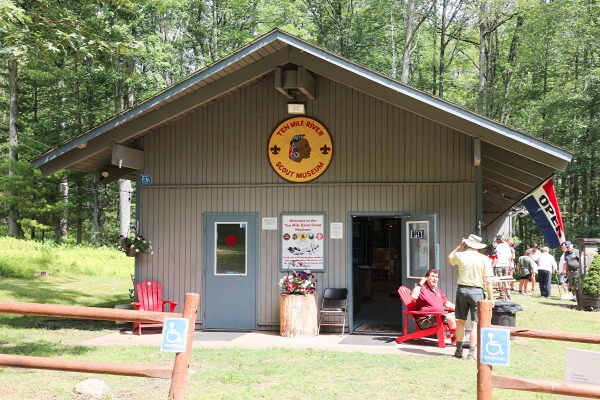
Before we head inside, let’s take a look around outside the museum proper at all of the relics of TMR’s past that populate the museum grounds.

To the left of the museum is the Cayuga/Kotohke Cabin. This is a typical type of cabin used in the 1930s and 1940s.

The interior is furnished as it would have been when it was in use by the Brooklyn Scout Camps. Displays cover other aspects of camp life at the time and the space is also used for presentations.
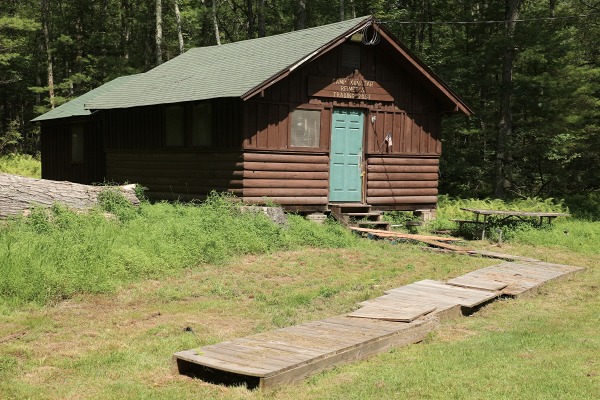
Further back, you’ll find the Camp Kunatah Trading Post.
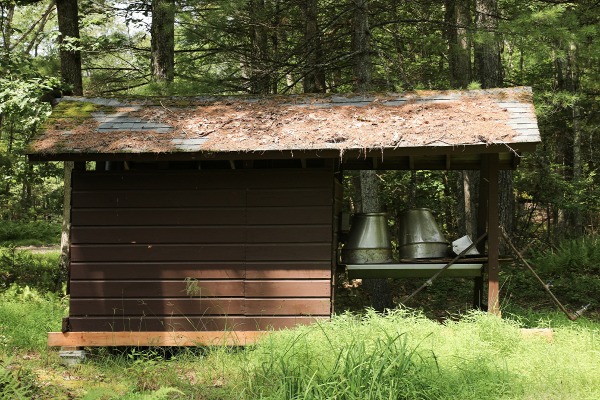
One of the museum’s newest additions is something quite familiar to anyone who camped at TMR from the ’60s to the ’90s – a latrine! It’s not exactly in display condition, but it’s sure to evoke memories of some kind.

Various signs from TMR’s past cover the left side of the museum.

This map shows Camp Aquehonga as it was when I camped there. A lot has changed, but this is how I will always remember it.
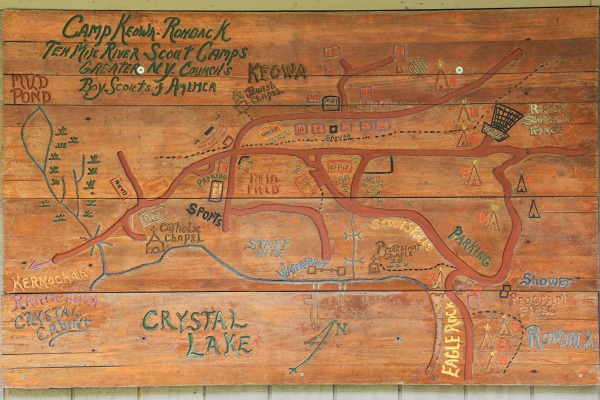
And here’s an old map of Camp Keowa, the only other Scout camp at TMR that is still in operation.

The picnic area is also home to this map of TMR from the 1960s that stood at the entrance to Headquarters Camp for nearly half a century.
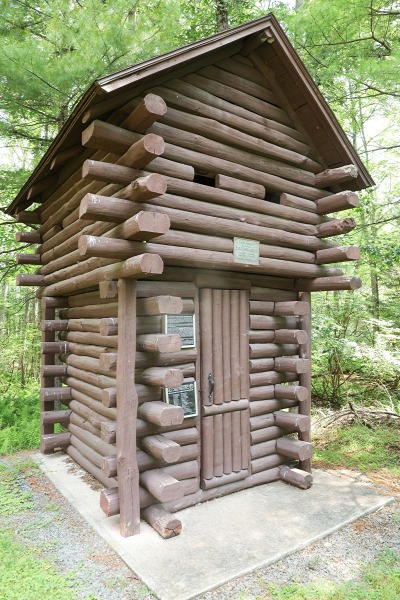
And our last stop is the Kernochan Blockhouse, which features displays on pioneer life in the Delaware Valley.
And now we’ll return to my 2022 visit of the museum…
My goal here was to look through the museum exhibits, keeping an eye out for anything pertaining to my troop or the Hudson-Delaware Council, and then search the trading post for anything of interest. I resisted the urge to go straight for the trading post, figuring that would be bad form.
There’s a lot on display in the museum, though it seems like far less than the whole story. Each exhibit is a different glimpse at some aspect of TMR, from the geology to the wildlife, early settlements, and camp history. You get the feeling that everything could be expanded several times over.
The staff photos make for a particularly interesting interactive display. People are identified wherever possible, turning it into a scavenger hunt for people for your troop or memorable counselors from years past. Gaps in the record and missing names make it more challenging, but I have the same problem with my troop photos from camp. Hopefully more materials get donated in the future to fill in some of the missing pieces.
One small display on the wall caught my eye because it contained several Hudson River District Scout Sunday patches, most of which were from events I attended as a Scout. They surrounded an article that mentioned Frank Speranza, scoutmaster of the other Cornwall troop, Troop 206 of Cornwall-on-Hudson. You never know what you’re going to find in a place like this.
It was a slow day at the museum, so most of museum co-director Ira Nagel’s focus seemed to be on me. I watched a short video on the history of TMR at his insistence, which filled in some gaps in the timeline for me. I felt bad turning down some of his other offers for guidance, but I was determined to make my way to the trading post.
Which I did just as the museum closed for dinner.
There aren’t a whole lot of dinner options in the area surrounding TMR, which is a risk I was well aware of when I opted out of the group dinner. So I set out with a full tank of gas and a vague idea of where to go in search of someplace that sold food, was open, and had somewhere to park. How hard could it be?
After passing several deer and some potentially promising populated areas, I found myself back at the Delaware River in Barryville. And that’s when I saw a restaurant with a large parking lot and several large “OPEN” banners fluttering in the breeze. Looks like that’s the place. Not knowing what to expect, I headed in and saw some now-familiar faces of TMR staffers. Definitely a good sign.
At this point, I was just killing time until the museum reopened. Killing time without a cellular signal – another risk I was well aware of before I set out. Eventually, I made my way back, easily retracing my path while keeping an eye out for the deer. The hardest part of the whole trip was navigating the parking area at Headquarters Camp.
Finally, it was time for the museum trading post. It was a long day with many challenging journeys, all leading up to this. Where to even begin?
The museum trading post was filled with memorabilia, from TMR issues filling the display cases to racks of uniforms, bins of patches, and boxes and binders of neckerchiefs. Not to mention the display of $1 mugs, which would have been far more tempting if I had a safe way to transport and store mugs. Maybe some day…
After looking over the display cases, I dug into the boxes of neckerchiefs. Finding mostly generic BSA neckerchiefs in various colors, I cut that search short and turned to the bins of patches, after giving the uniforms a quick glance. The patch bins yielded a couple of good finds, but a thorough search would take more than my back could handle. They could really use a coffee table and a couch or some bean bag chairs or something…
With people arriving for the cracker barrel, I knew my time was running short. So I finished out the search with the neckerchief binders, the contents of which were sorted alphabetically. And that’s where all the good finds were. From Beech Mountain neckerchiefs dating back to the days of the Orange-Sullivan Council to a Hudson-Delaware Council 1989 National Jamboree neckerchief, the binders were loaded with exactly what I was looking for. And so I left the museum with a stack of neckerchiefs, a few patches, and not much cash.
After that, It was off to the cracker barrel where we awaited the arrival of the group dinner contingent so the official alumni reunion check-in could begin. And we waited. And we waited…
Eventually, Johannes sent word that the group dinner was running long and evening check-in was canceled. Remember what I was saying about group dinners?
Part Four: Camp Aquehonga
My original plan for Saturday was to go straight to lunch at Camp Aquehonga, look around a little, and then make the 6-hour drive back home. I had other things planned for Sunday, so my time was limited. With check-in now opening on Saturday morning at the museum, I adjusted my plans to arrive a bit earlier but late enough that I could head over to lunch after maybe looking around the museum a little more.
As it turns out, my timing was perfect – for making it to the opening ceremony. I probably should have checked the schedule… The ceremony included new additions to the museum’s Wall of Fame. Among the honorees was Paul Lumpkin, former TMR chaplain and longtime Scouter with the Hudson Valley Council and Hudson-Delaware Council. I don’t know if I ever met Paul as a Scout, but I knew his sons from Skanondo Lodge. Or at least I knew of them. Details get a bit fuzzy after 30 years.
So about the check-in… By the time the ceremony was over, everyone involved in running things had scattered. The check-in table was gone without a trace, as was Johannes, who I had seen earlier during the ceremony. Out of leads, I headed to Aquehonga hoping that check-in, and my wristband for lunch, would be waiting there.
The trip to camp has changed in the decades since I last went to Camp Aquehonga in 1993. The main entrance off the Schiff Trail is no longer in use and the Schiff Trail is now closed to vehicle traffic. Instead, entrance is now via what used to be considered the back entrance, coming in out past Field Sports. The road was surprisingly comfortable once you got past the steep, narrow, washed-out section leading up to Barta House. The downside to coming in this way is that you have to go through the entire camp to get to the parking lot.
Not that anyone seemed to know that there was a parking lot. With a distinct lack of signage except signs saying where not to park, people just stopped anywhere there was room next to the road like this was 9W during the pandemic. Knowing (or, rather, hoping) better, I continued on until I reached the old parking lot, which thankfully had changed little since my last visit.

Everything else about Camp Aquehonga had changed considerably in the intervening decades. The Johnson Center was the most obvious change, along with a realignment of the parade field and camp road. But lunch had started and I needed a wristband, so that would have to wait. After a brief search, I found Johannes and the check-in table on the porch (was that here before?) outside the Canteen (still where it was decades ago).


In addition to the packet with my wristband for lunch and some other odds and ends, the check-in table had new TMR memorabilia for sale. Cash-only, of course. Having spent most of my cash the night before in the museum, I went with just the TMR 95th Anniversary patch and the Boy Scout Foundation of Greater New York 100th Anniversary patch.



The three CSPs would have to wait for another time.

Lunch was being served at a new (to me) pavilion. Even though it was technically catered, it still had the same feel as the camp barbecues.

The old Handicraft Lodge was a small shack with a porch between the services building and the staff site. (Sadly, I don’t have any pictures of it. In fact, the only pictures I took at Aquehonga as a Scout were of the mud trail in 1992, which I don’t think have ever been shown to anyone.) The new Handicraft Lodge not only has far more resources than the old one (that scrap wood pile alone…), but it also has a large pavilion suitable for use as an outdoor dining area. Which comes in handy when you don’t have a dining hall. This replaces the circus tent that used to be set up behind the pool.

Speaking of the pool, that has also changed quite a bit. While the pool itself looks the same, the open-air changing and shower areas seem to have been replaced with a new structure (not shown). And there’s now a water slide and shed extending out toward where the circus tent used to be.

With the camp offices moved into the Johnson Center, the old office building was repurposed into the Health Lodge and Nature Lodge. The new Nature Lodge is far more spacious than the old one and is loaded with books, exhibits, and equipment (including two huge telescopes). The front features a new duck pen and ramp and the back has a large porch, a separate canopy, and several interactive exhibits. You could easily spend an entire camp week here.

As nice as the new one is, it’s still sad to see the old Nature Lodge turned into a dilapidated storage shed. Sure, it was small and the exhibits were largely limited to handmade posters, but it was a great place to hang out and relax in the evening.

I’m not sure why the old duck pen is still there – this seems like a great place to clean up and use as a picnic area or something. A nice place to relax in the shade and not have to worry about anything… At least that way the spirit of the old Nature Lodge could live on.

Not much has changed on the outside of the services building. Inside though, the Commissary has been moved to the Johnson Center, freeing up space for a new Trade Skills Center. The Quartermaster and Canteen remain in the building.
The Canteen has changed a bit since I was last there. It now features separate entrance and exit doors and the large display case has been removed in favor of increasing the floor space accessible to customers. A small display case by the register had various camp patches and other memorabilia. Since credit cards were accepted (for everything except challenge coins and trail maps), I picked up one of every patch they had, plus a coin.
Also, there’s a slushie machine in there now. A water slide, a slushie machine… What’s next, indoor plumbing?

Yes, there’s indoor plumbing. In addition to the offices and the Commissary, the Johnson Center features air conditioning, a STEM lab, a lounge, and individual bathrooms with real toilets and everything.

There was lots more to see and do in camp that afternoon. I particularly would have liked to check out the changes to the rifle range, but time was running short if I was going to make it home by dark. Since I never made it over to Site 4 (I don’t even know if that would have been allowed), I took a quick photo of Site 1A on my way back to the parking lot. And with that, I said goodbye to Camp Aquehonga once again. Hopefully I make it back in less than a quarter of a century…
2023 Update: As it turns out, I was back the next year. I was in no rush this time and checked out the new additions for 2023.

The main showcase for this year was the all-new Scoutcraft area. When I was a Scout, Scoutcraft was dark and damp and didn’t have much going for it beyond the COPE course that ran overhead. Now expanded out into newly cleared space, Scoutcraft is filled with information displays and interactive challenges.

Fire safety is a big theme near the campfire, with a bucket brigade challenge just inside the entrance…

…and Indian tank target shooting further down past the fire building challenge area where burning through a string will dunk a bucket of water on whoever is sitting on the log.
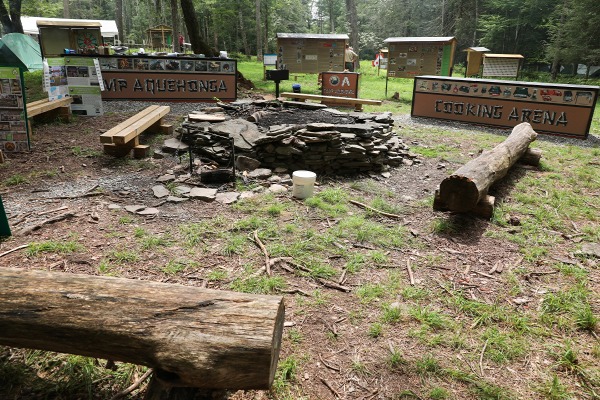
And here’s the campfire and the cooking arena. This area is filled with displays and equipment, including a pizza oven that was in use alongside sausage cooking on a grill. This turned out to be a better lunch option than the official lunch at Handicraft…
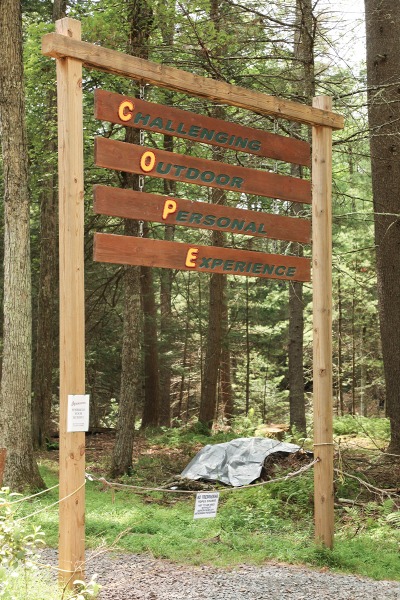
Finally, here’s the COPE course with its own dedicated space.

And that’s it for 2023. The festivities have been moved to Camp Keowa for 2024, so we won’t be seeing the updated waterfront area at Aquehonga.
—
With that, this year’s anniversary project is complete. What, were you expecting it to be about something more relevant, like the 1993 National Jamboree? Unfortunately, I don’t have much to say about that beyond what you can find on Wikipedia. And one year still counts as an anniversary, so unless I’m forgetting about some other convenient anniversary that would maybe serve as a lead-in for a discussion about memorabilia, it looks like we’re done for this year. And with more than 6 months to spare!
Addendum
I met up with Johannes and others at the Kintecoying Trade-o-ree the following November, where I was finally able to grab those CSPs I didn’t have the cash for previously. And while I picked up a few other key pieces of memorabilia while I was there, the most valuable thing I got was information. A month earlier, the decision had been made to discontinue the summer camp program at Camp Ranachqua. With this, the last camp operated by the Hudson-Delaware Council was effectively closed, ending a legacy of summer camping that had lasted for exactly 100 years. It all started with an Orange County Council executive board meeting in November of 1922:
[Scout Executive Clarence W. Hunter] suggested that a camping program should be adopted and the committee areed [sic] with him, deciding on a county encampment, site to be selected later.
That one statement set in motion events that would lead to a century of building camps, overcoming obstacles, teaching skills, fostering fellowship, and generating controversy. But that’s a story for another time.
TO BE CONTINUED



